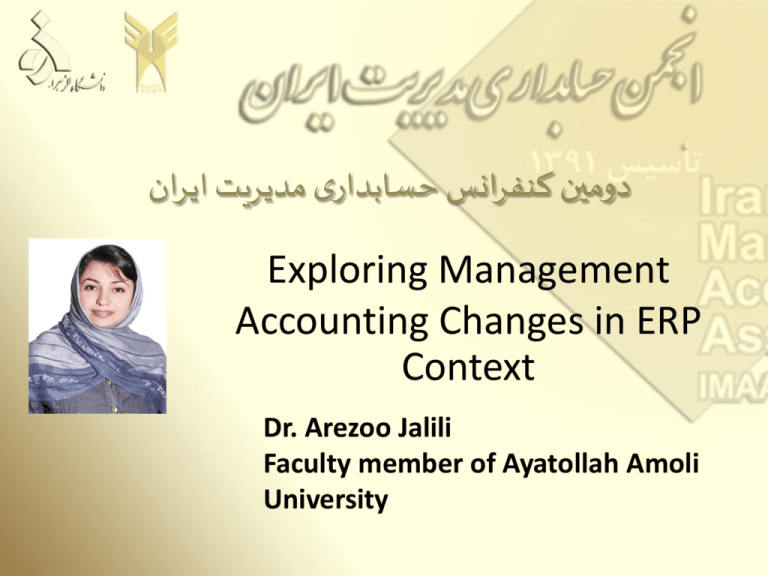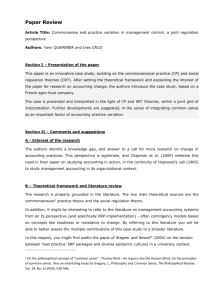
دومین کنفرانس حسابداری مدیریت ایران
Exploring Management
Accounting Changes in ERP
Context
Dr. Arezoo Jalili
Faculty member of Ayatollah Amoli
University
overview
•
•
•
•
•
•
•
•
Introduction to ERP
Evolution of ERP
Planning & controlling in ERP
Management Accounting Architecture in ERP
Overhead Cost Controlling Accounting
Product Cost Controlling
Profitability Analysis
ERP researches in management Accounting
مدیریت هزینه و اقتصاد مقاومتی، دومین کنفرانس حسابداری مدیریت ایران،1393 اول خرداد ماه
Introduction to ERP
Enterprise Resource
Planning Systems
3
Business Enterprise
Products
Customer
Orders
Materials
Order Entry
System
Customer
Sales
Account Rec
Customer Database
Manufacturing
and
Distribution
System
Procurement
System
Production
Scheduling
Shipping
Vendor
Accts Pay
Inventory
Manufacturing
Database
Procurement
Database
Traditional Information System with Closed
Database Architecture
Purchases
Supplier
Business Enterprise
ERP System
Legacy
Systems
Data Warehouse
ERP System
On-Line Analytical Processing
(OLAP)
Bolt-On Applications
(Industry Specific Functions)
Suppliers
Customers
Core Functions [On-Line Transaction Processing (OLTP)]
Sales
&
Distribution
Business
Planning
Shop Floor
Control
Operational Database
Customers, Production,
Vendor, Inventory, etc.
Logistics
Evolution of ERP
Source: http://www.intelligententerprise.com/020903/514feat2_1.shtml, viewed September 19, 2013.
6
SAP Business Suite
SAP PLM
SAP
SRM
SAP
ERP Central Component
(ECC)
SAP SCM
SAP NetWeaver
SAP
CRM
Controlling (CO)
SAP Module View
Financial
Accounting
Sales &
Distribution
Materials
Mgmt.
Controlling
R/3
Production
Planning
Human
Resources
Quality
Maintenance
Fixed Assets
Mgmt.
Integrated Solution
Client / Server
Open Systems
Plant
Management
Project
System
Workflow
Industry
Solutions
Enterprise Operations Planning
OP Execution
High-Level OP Planning
Procurement
Process
CO/PA
Detailed OP Planning
Forecasting
Sales and Operations
Demand
Planning
Management
MPS
Sales Information
MRP
Manufacturing
System
Execution
Warehouse
Strategy Planning
- Vision
- Goals & Objectives
- Strategy
Management
Sales
Process
Execution
- Product Portfolio and Roadmap
9
Enterprise Planning stages and Levels
Planning
Stages
Planning
Levels
Vision, Goals,
& Milestones
Actions &
Quantities
(cost, time, &
peformance)
Approval &
Rejection
Budget
Top Management
Controlling
Division
Cost Center
Source: Freyburger
Finance
Approval
11
Components of Managerial
Accounting
Internal
Orders
Cost
Element
Acct
Controlling
(CO)
Cost
Center
Acct
Profitability
Analysis
Activity
Based
Costing
Product
Cost
Controlling
Profit
Center
Acct
12
Cost Elements
Controlling
Financial
Accounting
Total Cost Elements
General Ledger Accounts
Income
Statement
Secondary Cost
Elements
Primary Cost
Elements
Balance
Sheet
Expense
Accounts
Revenue
Accounts
13
Cost Element Overview
•
•
•
•
•
Cost Element Groups
Cost Elements
Primary Cost Elements
Secondary Cost Elements
Statistical Key Figures
January 2008
© SAP AG - University Alliances and The
Rushmore Group, LLC 2007. All rights
reserved.
14
.Cost Center Accounting
Cost Drivers
•
A cost driver is a factor, such as machine hours, beds occupied,
computer usage time, flight hours, or any other factor that causes
overhead costs.
•
Most companies use direct labor-hours or direct labor cost as the
allocation base for manufacturing overhead,
•
However, major shifts are being made in the way cost is structured. With
the increased usage of sophisticated and complex equipment in
manufacturing, there is less direct labor relative to overhead as a
component of product costs.
Typical cost driver types: activity types and statistical key figures.
•
15
Profit Center Accounting
Profit Center
• Profit centers are similar to business areas, in the sense that they are set
up for internal reporting purposes. Profit centers, however, are formally
defined as components of a controlling area, not as components of one or
more company codes.
• Income statements may be created for profit centers, and selected assets
may also be reported for profit centers, but not complete balance sheets
(which can be done for business areas).
• Enterprises are commonly divided into profit
centers based on
•
•
•
Region
Function
Product
17
18
Profitability Analysis (PA)
•
The profitability analysis (PA) module within CO provides the means for
assigning planned and actual revenues and costs to a variety of
profitability segments, including customers, sales territories, sales
employee groups, product groups, etc.
•
This provides great flexibility in defining, both the market characteristics
that are of interest to managers, and the related performance measures
(e.g., gross margin, contribution margin, segment margin) that managers
use to evaluate market segments.
19
20
• ERP Researches in
management Accounting
Slobodan Malini´c Mirjana Todorovi´c(2012)
Slobodan Malini´c Mirjana
Todorovi´c(2012)
The conclusions are that SAP reduces the time required for the traditional
tasks of management accounting, while increasing the time required for the
activities of data analysis, performance measurement and subtle strategic
reporting.
Aidan O' Mahony& John
Doran(2008)
• In conclusion the findings suggest that the ERP
system has had a positive effect on the role of the
management accountant.
• ERP is one of the major contributors to the change
in the role of the management accountant.
Accounting personnel feel that ERP allows them to
expand their roles and instead of producing figures
allows time for further analysis and value adding
activities in areas such as cost control.
Hazar Daoud& Mohamed Triki (2013)
Moorthy, Voon, Samsuri, Goplan, Tak yew (2012)
The study talked about the application of information technology in management accounting decision
making. The authors used the information technology tools in order to analyze management accounting
decision making. The study also tried to apply and connect information technology tools in management
accounting in order to control cost and to improve the efficiency of management accounting.The study
concluded that using information technology in management accounting will result in better financial
reports which will finally lead to better decision making.
Galani, Gravas, Stavropoulos (2010)
The study discussed the impact of ERP systems on accounting process. The study introduced the Enterprise
Resource Planning (ERP), to be used in modern management accounting. Using such system will make on
reducing costs, and make better decision making. The study concluded that, using ERP will lead to better
relation between the company and its suppliers and customers
Brandas (2010)
The study discussed the effects of decision support system model based on rules and OLAP for costs
management. The paper disclosed a decision making model (DSS), for costs management through the use
of business intelligence tools such as OLAP. The study concluded that, using business intelligence tools as
OLAP, will lead to effective control of business activities, which will lead to achieve the goals of the
enterprise.
Strumickas &Valanciene (2010)
The study discussed the development of modern management accounting system. The study also discussed
the practical and the theoretical parts, in the development of management accounting system within the
environment of the enterprise. The study concluded that, management accounting system is affected by the
internal, external environment and objectives of the enterprise
نتایج نشان داد که
بنی اسدی ،میهن ارائه چهارچوبي مفهومي از عوامل كلیدي آموزش ،ارتباطات
دوست ( )1392موفقیت در پیاده سازي ERPدر شركتهاي كوچك شرایط محیطي كه
و متوسط)(SME
تاثیرات مختلفي بر
داشته باشد.
حجازی-
اسماعیلی
کیا()1392
تاثیر سیستمهای برنامهریزی منابع سازمان
بر اثربخشی کنترلهای داخلی در رابطه با
گزارشگری مالی
تیم پروژه ،حمایت مدیریت ارشد ،مشاوران،
موثر ،فرهنگ سازمانی ،ارزیابی عملکرد و
هر سازمان در آن فعالیت مي كند مي تواند
نحوه پیاده سازی ERPو عوامل موثر بر آن
یافته های پژوهش نشان داد که شرکتهای دارای سیستمهای
برنامه ریزی منابع سازمان نسبت به
نمونه کنترل شرکتهای فاقد سیستمهای برنامهریزی منابع
سازمان کمتر احتمال دارد که ضعف کنترل
داخلی داشته باشند .همچنین شرکتهایی که زیانده بودند ،در
دوره مذکور فعالیتهای ادغام و
تحصیل داشته اند ،ارزش بازار کمتری داشته اند و عمر
استقرار سیستمهای برنامه ریزی منابع سازمان
آنها کوتاهتر بوده ،احتمال کمتری در وجود ضعف در سیستم
کنترل داخلی داشته و سطوح پایینتری
از ضعف را تجربه میکنند
نتایج تحقیق نشان داد كه برنامه ریزي منابع بنگاه باعث افزایش
زنجیردار ،احمدی بررسي اثرات پیاده سازي ERPبر ویژگي هاي
ویژگي هاي كیفي شامل مربوط بودن ،قابل اتکاء بودن ،قابل فهم
()1391
كیفي اطالعات حسابداري
بودن و قابلیت مقایسه اطالعات حسابداري مي شود.
مالنظری-
زراعتی
فرد()1391
بررسی نقش وجود عوامل نوآوری در
پیادهسازی موفق برنامه ریزی منابع
سازمان
نتایج حاکی از آن است که فشار رقابتی هم بر رضایت کاربر
و هم بر بهبود عملکرد سازمان تاثیر با اهمیتی دارد .و
علیرغم اینکه آموزش ،درک پیچیدگی و حمایت مدیر ارشد
تاثیر با اهمیتی بر رضایت مدیران عملیاتی در استفاده از
سیستم جدید داشته ،اما در بهبود عملکرد سازمان نقشی نداشته
عباس زاده
()1389
برهانی یزدی -
پورعباس
()1389
آقایی ()1383
ارزیابی آثار سیستمهای ERPبر رویه های این سیستم ها بر نقش حسابداران مدیریت تاثیر گذاشته است و
حسابداری مدیریت و نقش حسابداران مدیریت اطالعات دقیق تر و به هنگام تری برای بودجه ها و گزارش ها
فراهم می کند.
اجرای ERPدر سازمان و موسسات وابسته ،بیشترین تاثیر خود را
بررسی دستاوردهاي پیاده سازي سیستم ERPدر حوزه منابع انسانی می گذارد .در نتیجه این سیستم بیش از آنکه
(مطالعه موردي سازمان هولدینگ و موسسات بعد فنی و تکنیکی داشته باشد در ابعاد مدیریت و منابع انسانی
وابسته)
تاثیر دارد(ریسک شکست پیاده سازی سیستم را در حد قابل
توجهی در سازمان کاهش می دهد).
بررسی تاثیر فناوری اطالعات بر ویژگی های طبق نتایج تحقیق ،کیفیت مربوط بودن اطالعات حسابداری که
کیفی اطالعات حسابداری
بطور عمده از به موقع بودن اطالعات ناشی می شود و همچنین
قابلیت مقایسه اطالعات مالی روند شرکت ؛ افزایش یافته اما کاهش
قابلیت اعتماد اطالعات و قابلیت مقایسه اطالعات بین شرکتهای
مختلف را نشان می دهد.
فرقاندوست -مشکالت پیاده سازی سیستم برنامه ریزی رابطه بین بکارگیری موفق سیستم برنامه ریزی منابع
درخشانفر( 138منابع سازمان در شرکت های صنعتی سازمان با ارتقاء سطح دانش کارکنان و امکان تهیه گزارش
منتخب از دیدگاه مالی
)7
های متنوع تایید شد ولی رابطه بین بکارگیری موفق سیستم
و کاهش هزینه ها ،امکان ارتباط اینترنتی با مشتریان و
هماهنگی با تامین کنندگان مورد تایید قرار نگرفت
Conclusion
• To achieve competitive advantage in the global
economy, organizations are extending their
ERP system beyond the firm.
• Future growth of the industry lies in adding
extensions.
• Integration, scalability and flexibility issues.
29










